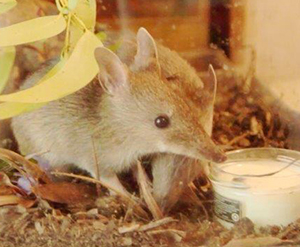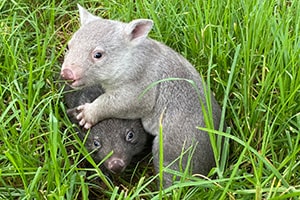Bandicoots
Bandicoots are nocturnal, solitary animals occurring in a wide variety of habitats throughout Australia. All bandicoots are protected as they are native Australia animals. Some sub-species of Bandicoot, like the Southern Brown Bandicoot are now listed as endangered in NSW.
Appearance
Bandicoot size varies between species, adult head-body length ranging from approx. 30-43cm, weight between 500-1900gms. The males are larger than the females. Bandicoots are generally light greyish-brown in colour, and have a characteristic long slender nose used for foraging in soil, rotting wood or in rock cervices. The coat is generally sleek and coarse haired. The hind legs are longer than the front legs and carry most of the animals’ weight. The hind foot resembles that of a kangaroo. The toes have long sharp claws suitable for digging in soil. Bandicoots have excellent hearing and eyesight and they can emit a sharp, high-pitched squeak when foraging.
Breeding
Bandicoots are able to breed at any time of year. Nests are made of grasses which are pulled or woven together and often located under an overhang or dense thicket. They may also been found in long grass or low shrubbery in a protected spot. Bandicoots are marsupial but unlike the pouch of a kangaroo, the bandicoot’s pouch slopes downwards and backwards, opening at the rear, protecting the young while the mother is digging in the soil.
Bandicoot young stay in their mother’s pouch for approximately 50 days, weaning occurring at about 50-60 days. After this time, the animals have to fend for themselves.
Bandicoots in the garden
Bandicoots are known as the gardener’s best friend. Although they eat some native fruits and berries they are dependent on protein and consume a wide variety of surface and soil dwelling invertebrates including; earthworms, earwigs, cockroaches, crickets, grasshoppers, spiders, adult beetles, beetle larvae and pupae, moths, ants and termites.
Conical holes in your lawn mean bandicoots have been looking for food and eating a range of destructive insects before they ruin your lawn. By digging, the animals also aerate the lawn so in grows back with renewed vigour.
Bandicoots cause no long term damage to gardens or lawns and they will only stay in your yard while there is a suitable food source and then they move on.
If you have bandicoots in your yard please do not use any pesticides. If you wish to deter bandicoots from a specific area in your yard, you could floodlight that area as they do not like bright lights. You could also try Dynamic Lifter or chicken poo as it has a strong smell which most animals dislike. A combination of both bright light and smell appear to have the greatest effect as bandicoot deterrents.
Rescuing Bandicoots
If you find a sick, injured or orphaned bandicoot please call WIRES Rescue Office 1300 094 737 or fill in the Rescue Form. If the bandicoot is sick or injured it will need to see a vet before coming into care, if you are able to safely contain it, you can keep it in a quiet, dark, warm place e.g. wrapped in a towel in a ventilated box or carrier with a lid while you transport it to the nearest vet. If you let WIRES know which vet you have taken the bandicoot to, we will follow up with the vet directly to bring them into care after they have been vet assessed and received any necessary treatment.
Newsletter
Stay in touch with our regular rescue stories and WIRES updates.


